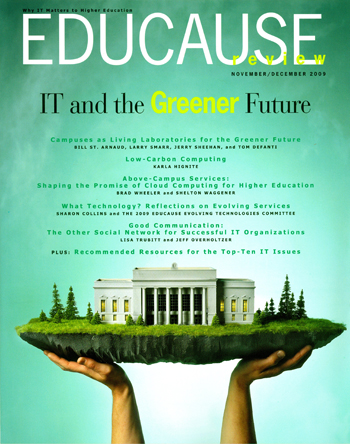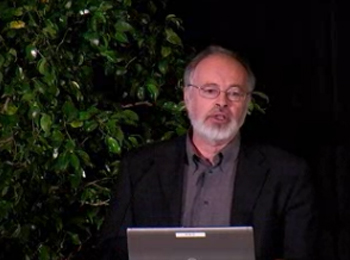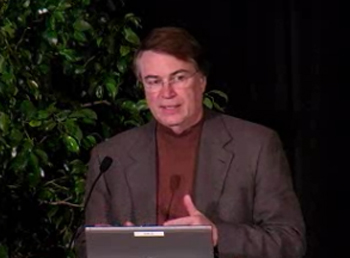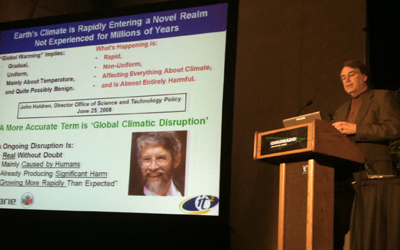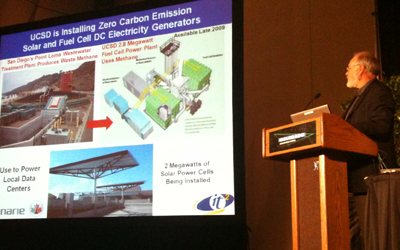Universities Challenged to Develop Technology Solutions for a Carbon-Constrained World
Calit2 and CANARIE See Campuses as Living Labs for a Greener Future
San Diego, Dec. 3, 2009 -- In the November-December 2009 issue of the journal EDUCAUSE Review, senior information-technology researchers from California and Canada make a strong plea for colleges and universities to take the lead in finding solutions to what President Obama's science advisor calls 'global climatic disruption.'
|
Publication of the cover story, “Campuses as Living Laboratories for the Greener Future,” coincided with a joint keynote address two of its authors: Larry Smarr, Director of the California Institute for Telecommunications and Information Technology (Calit2);, and Bill St. Arnaud, Chief Research Officer of Canada’s CANARIE, Inc., Canada’s high performance research and education network. The keynote took place in early November at EDUCAUSE’s 2009 annual conference in Denver. EDUCAUSE is a nonprofit association and the foremost community of IT leaders and professionals committed to advancing higher education.
“Campuses are small cities, so they are ideal for creating living laboratories for large scale experiments probably a decade ahead of society,” said Smarr, who is also the Harry E. Gruber Professor of Computer Science and Engineering in UCSD’s Jacobs School of Engineering.
Framing the issue with a reference to the land grant universities’ original role in developing agriculture and early industrial technologies, Smarr added: “I am optimistic that if campuses research how our society can quickly adapt to climate change we will be seen as re-inventing our charter for the 21st century.”
|
Smarr and St. Arnaud co-authored the cover story in EDUCAUSE Review with Calit2 Senior Research Scientist Tom DeFanti, and the institute’s Chief of Staff, Jerry Sheehan, as well as a white paper published as a Web exclusive on the EDUCAUSE site (see Related Links below). The Web article covers a brief review of the scientific basis for concern about continued carbon emissions into the atmosphere and how carbon regulation (like the cap-and-trade legislation being considered in the U.S. Congress) will impact universities financially.
“By transforming their building, transportation, and electrical-generation energy subsystems into instrumented testbeds,” wrote Smarr and his co-authors, “institutions can use their actions to reduce carbon footprints as learning and optimization environments for society at large.”
|
“We are moving into unexplored territory, climatically speaking,” said Smarr. “The world will try to slow down the growth in carbon emissions we are dumping into atmosphere, but with the atmosphere will retain most of these emissions for over a thousand years! We are literally terraforming the planet permanently, from a human time-scale, so we need to limit the damage.”
“Larry's and Bill's Educause presentation on ‘green IT’ was extremely constructive,” said George O. Strawn, Chief Information Officer at the National Science Foundation. “Not only did it do a good job of showing the magnitude of the ‘climate change’ problem we face, it also showed how the higher education and the IT communities could be of great help to the world in solving or at least mitigating the problem.”
A big part of the problem is the carbon footprint of the global ICT industry, which accounts for between 2% and 3% of total greenhouse gas emissions, and growing at 6 percent a year.
Paradoxically, even more use of ICT could help reduce emissions from other sectors. “If we make much better use of information technology than we are currently doing, if we extend the Internet throughout the physical world into our cars, into our buildings, into our electrical or ‘smart’ grids, then we have a chance to get a reduction of five times the scale that the ICT industry is generating,” said the Calit2 director in his keynote. “This is the low-hanging fruit.” However, to make more use of more ICT, it must cause much lower carbon emissions than it does now.”
|
UCSD’s efforts to increase building energy efficiency have focused on deploying sensors in 34 buildings on campus that create a “real time” monitoring platform for understanding power use in campus facilities. This research, led by Computer Science and Engineering Faculty Member Rajesh Gupta's team, has led to the development of the Energy Dashboard to help improve the visibility of energy consumption on the campus.
Professor Gupta and his co-workers have done detailed analysis of the UCSD computer science building, which contains 500 people but 750 computers, in much greater detail. One early conclusion: The base electricity load for the CSE building runs about half of the peak load. PCs and servers account for 70 percent of the base electrical load in those buildings, and 90 percent of that load could be avoided. The conclusion of the published research, according to the EDUCAUSE Review article, “More than half of the current baseline electrical usage for the CSE building could be saved by selective reduction in energy use of computers when they are not being used.”
In addition to reducing emissions from buildings, Calit2 has also made a conscious effort to reduce travel through the use of telepresence. The Institute has deployed commercial high definition teleconferencing systems from vendors such as Cisco and LifeSize to support multiple participant meetings between the two campuses and has actively experimented with tools such as Skype to support individual teleconference meetings and telecommuting. Calit2 also leads global research efforts to use high performance optical networks and telepresence software developed by the Institute to support scientific collaboration through projects such as the Optiptuer and the work with King Abdullah University of Science and Technology.
UCSD and UCI are also converting their fleets of vehicles to run on renewable energy, and investing in solar power. At UCI, the Advanced Power and Energy Program (http://www.apep.uci.edu/) — which consists of the National Fuel Cell Research Center (NFCRC), the UCI Combustion Laboratory, the Distributed Technologies Testing Facility, and the Pacific Rim Consortium on Combustion, Energy, and the Environment — is working with Toyota to test early models of plug-in electric hybrid cars. Over the last decade, the NFCRC and the Institute of Transportation Studies have also tested all-electric and hydrogen fuel cell vehicles, and they operate two hydrogen-refueling stations. In 2007, UCI became the first campus in the nation to retrofit its shuttle system for B100 (pure biodiesel), reducing campus carbon emissions by an estimated 480 tons annually. UCSD also has an ambitious program under way to reduce the carbon footprint of its fleet, of which approximately 45 percent are already alternatively fueled vehicles. Included in this number are over three hundred small electric and more than fifty hybrid vehicles. Additionally, the UCSD campus fleet has converted its entire diesel fuel supply to a B20 biodiesel blend. Finally, through a partnership with San Diego Gas & Electric, in 2010 the campus will take delivery of its first all-electric, full-sized vehicle: the Nissan Leaf. Through grant funding from the U.S. Department of Energy, the campus will also receive charging infrastructure along with the electric vehicles. By 2011, UCSD will have as many as twenty full-sized electric vehicles in its inventory.
As more and more disciplines adopt digital methods to support research, a greater percentage of a campuses electricity and cooling usage comes from data centers, whether in departments or campus shared facilities. To understand how to use software to enhance the energy efficiency of computers, servers and data centers, Calit2 proposed and was funded by the NSF for the GreenLight project. Calit2 is building the GreenLight Instrument inside a shipping container outfitted by Sun Microsystems as a modular data center. By linking the container to UCSD’s internal 10 gigabit-per-second network and links to local, national and international high-speed networks, researchers thousands of miles away will be able to study the energy cost of computing, and enable scientists to explore tactics for maximizing work per watt.
|
According to the EDUCAUSE Review article, colleges and universities will soon have to begin to “measure and abate campus greenhouse gas emissions or face potential fiscal repercussions.” Most major U.S. universities will become regulated entities in 2010, following a U.S. Environmental Protection Agency ruling that all institutions emitting over 25,000 metric tons of CO2 equivalent must begin measuring emissions this January, and begin reporting on those emissions as of January 2011. As an example, UC San Diego is roughly a 40 Megawatt campus and had nearly 200,000 metric tons in gross emissions in 2008, and campuses in areas that rely on coal-fired power plants have easily double UCSD’s emissions. As a result, carbon cap-and-trade systems – now being debated in Congress – will have an uneven impact on U.S. universities.
According to CANARIE’s Bill St. Arnaud, Canada is already grappling with government legislation at both the national and provincial levels. British Columbia, for example, has already mandated that public sector organizations must be carbon neutral by 2010, and if not, they will be required to purchase carbon offsets at $24 per ton. For the University of British Columbia, the rule will cost the campus an average of $3 million per annum for the next three years.
As the authors write in the conclusion of their EDUCAUSE Review article: “Higher education institutions have a long and successful history of creating both scientific and technological innovations for the benefit of society. Indeed, the U.S. land-grant institutions were established, in large part, to support the need for leading-edge research in the dominant industry of the time: agriculture. Today, those of us in higher education have the opportunity to recommit ourselves to enabling societal transformation by using our campus "cities" as proofs of concept for the green infrastructure revolution. By focusing not only on how we can make our campus cyberinfrastructure more energy-efficient, but also on how we can use that cyberinfrastructure for even larger energy savings in our building and transportation infrastructure, as well as adopting dematerialization tactics, we can learn a number of best practices that can be transferred to society at large, thereby speeding the day when global [greenhouse gas] levels will stabilize.”
Related Links
EDUCAUSE Review: Campuses as Living Laboratories for the Greener Future
EDUCAUSE Review: Climate Change and Higher Education
EDUCAUSE 2009 Webcast and Presentation
Smarr and St. Arnaud Presentation Podcast
Media Contacts
Doug Ramsey, 858-822-5825, dramsey@ucsd.edu

